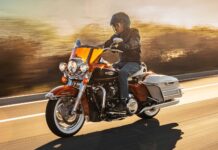Every motorcycle accessory catalog is built on the premise that the motorcycle rider wishes to change what the factory has created by replacing original parts with custom pieces. Changing stock engine parts to make the machine more powerful and get better gas mileage is common as is the addition of chrome covers, crash bars, boxes, packs and the equally common removal of chrome covers, crash bars, boxes or packs. All of this is done with the intent of making the riders more comfortable, more stylish, and therefore more in tune with the road and their own inner being.
The propagation of individual decorations and go-fast engine parts is big business in the motorcycle industry and is so prevalent that one would be hard-pressed to find a motorcycle as it came from the factory, without having been ingratiated with even the smallest adornment.
The hope of every rider is that when they spend their hard earned money those purchases will make them at one with said machine, express who they are and turn the machine into an extension of themselves. Paint and chrome are only good for keeping off rust and making things shiny. So, why else would a person spend thousands to paint flames over a perfectly good factory paint job or chrome anything unless they wish to personalize their bike until it screamed, “This is mine, this is who I am, this is who I wish to be when I ride. Take a good look but don’t touch, this is the real me.” Catalogs pander to such notions.
Years ago the parts and accessories department of your favorite motorcycle shop sold spark plugs, oil, tires, batteries and maybe T-shirts. Now, many shops make more money on T-shirts and accessories than they do on motorcycle sales. Harley dealers add on or sell extras to every bike that leaves the dealership. Is there a new bike owner who hasn’t added something to his recent purchase? Is there a Honda Gold Wing rider who hasn’t added a chrome cover of some kind to their new ride? Is there any new rider who doesn’t have an accessory catalog with pages marked and items circled for their Christmas list or birthday present? There must be such a person, somewhere, but I would bet they are few.
The person without a catalog is certainly not me. I am an accessory freak. I love all the bits and pieces. Every motorcycle magazine calls attention to “new products” and those are the first sections I peruse. If a rider gets to heaven by leaving his motorcycle bone stock and unencumbered by beautification attempts or the adding or subtracting of gee-gaws and brick-a-brack then I am not without sin and am bound for the eternal fire of the nether regions.
The motorcycle accessory business is big business, and yes, it is a welcome business. Thank God for such companies. Without them making specific products geared exactly for the motorcycling community we would all be wearing work boots from Sears instead of fancy biker’s boots, army surplus jackets instead of leather jackets with removable liners, zippered vents, and Gore-Tex linings and we would be paying the guy at the gas station to weld brackets to the back of our motorcycles for the addition of running lights we found at the junkyard.
One of my several motorcycles is an inexpensive street-legal dual-purpose bike. When it was new, I rode it on a trip with one of my Harley friends who commented that he would like something like it to take on dirt roads. “Then why don’t you buy one?”
“No, I am sure it’s too expensive.”
“They’re cheap. The dealers are giving them away.”
“Yeah, right.”
“No, really. I bet you have more money invested in accessories on your Harley than I have in this whole bike.”
He bet me he didn’t, we added up everything and he paid off the bet by buying me lunch. Of course, today I would lose the bet because I have added stuff to the dual-purpose bike.
So, what happens when everyone has outfitted their bike to show the world who they are and what they are about? A bike show, of course.
My personal favorite show winner was a man who owned a Honda Gold Wing. Originally, he decked it out with lights, lasers and flashers, which put on a show accompanied with music. He won the lightshow category. But that was not enough. The next year he added new paint with murals of bears and elks playing in the Grand Tetons. That year he won the lightshow and the paint category. Finally, he decided to go all the way. He wanted to win the overall trophy so he refined the laser light/music show, spruced up the paint with pin striping and added a matching sidecar and trailer to also win the touring class.
Interestingly, I noticed the mileage on the rig. It was just under 1,000 miles. I asked him about it, and he said, “I haven’t ridden it much but someday I’ll plan a big trip.”
So how do you know when enough is enough?
I have my way of testing when I have spent enough. When I have the proper luggage so that I can go on a trip and not tie things to my bike with string… when a poor-fitting seat doesn’t tell me when to get off the bike… when the lights work and I can see at night and cars can see me… when the paint keeps off rust… when my riding gear lets me ride in the dark, cold, wet and heat of summer… when I have stuff that works correctly and I think I look suited to the bike then all is right with the world.
Yes, I am as vain as any other rider. Several miles from my shop there is a real estate office, a business building with a huge plate glass window. The street has little traffic and isn’t busy. At 20 mph, I have plenty of time to check out my reflection in the window. I know when it feels right and when everything looks reasonable.
It’s my bet that every biker alive also knows where there is a large reflective plate glass window. After all, bikers profiling with fancy paint, new pipes and shiny chrome is all part of the game.




















